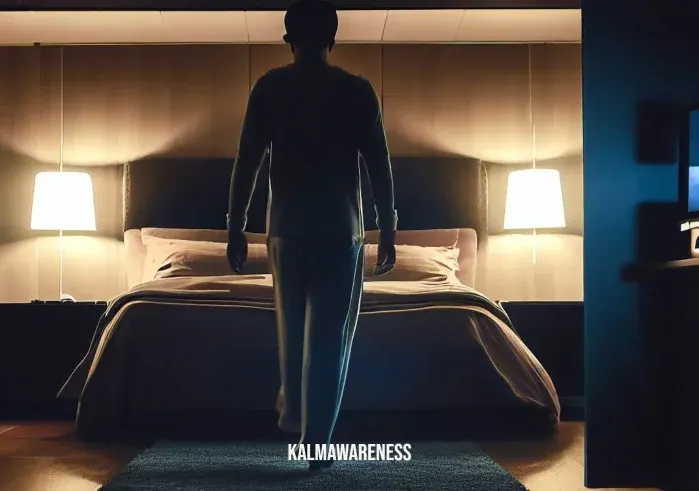Fast Sleep Meditation: Achieve Deep Relaxation Effortlessly
In the hustle and bustle of life, finding time to meditate can be a challenge. Yet, the need to relax and unwind is more crucial than ever. Fast sleep meditation is an accessible and practical solution. It integrates the art of mindfulness and the science of sleep into a brief practice that can fit into even the busiest of schedules.
The Wonders of Fast Sleep Meditation
Fast sleep meditation utilizes short meditation techniques to ease the mind and body into a state of deep relaxation. This state is ideal for sleep preparation, providing a peaceful transition from wakefulness to sleep.
Contrary to common misconceptions, meditation doesn’t require an hour-long session sitting cross-legged. Some highly effective practices last just three minutes, or even a mere two minutes. Short meditations, when done consistently, can offer profound benefits including reduced stress, improved focus, and, crucially, better sleep.
“Fast sleep meditation brings together the power of mindfulness and the comfort of your own bed to create an environment conducive to restful sleep.”
You might think that carving out time for meditation is impossible with your packed schedule. However, fast sleep meditation offers a way to incorporate mindfulness into your daily routine without demanding substantial time. Practices like 5-minute sleep meditation or the 12-minute guided meditation are perfect for busy individuals seeking restful sleep.
Setting the Stage: Your Quick and Calm Bedtime Routine
As part of your bedtime routine, consider some quick relaxation techniques that complement fast sleep meditation. Simple exercises such as brief meditation on breath or a short body scan can set the stage for a fruitful meditation session and a tranquil night’s sleep.
A 5-minute meditation timer can also be beneficial to ensure your practices stay within the desired timeframe. As you progress, you may find that extending the duration of your practices, for example, to a 20-minute sleep meditation, can further enhance your sleep quality.
Engaging the Breath: The Heart of Meditation
At the heart of many meditation practices is the breath. Cultivating mindful breathing can be an essential step in achieving a calm and centered state. The practice of focusing on your breath can be done in as little as three minutes, making it a versatile tool for fast sleep meditation.
Taking a moment to cultivate calm through breath-focused practices can work wonders in quieting the mind, making the transition to sleep a much smoother process.
In the next part of the article, we’ll delve deeper into specific fast sleep meditation techniques and share insights on how you can integrate these practices into your nightly routine. From learning about guided sleep meditations to understanding the link between meditation and deep sleep, there’s plenty to look forward to. Join us as we continue our exploration of fast sleep meditation.
Sleep is an essential component of our lives. We all need it, and when we don’t get enough, we feel it. Stress, anxiety, and our busy schedules can often hinder us from getting the rest we need. One practical solution that’s gaining popularity is fast sleep meditation. This technique not only helps you fall asleep quickly but can also improve the quality of your sleep.
At KalmAwareness, we believe that a good night’s sleep is achievable and should not be an uphill battle. We offer a variety of resources to help you understand and apply fast sleep meditation, and to guide you towards a more peaceful sleep.
Understanding Fast Sleep Meditation
Fast sleep meditation refers to techniques aimed at calming the mind and preparing the body for restful, quality sleep in a relatively short period. Think of it as a brief exercise for the mind that facilitates the transition from the hustle and bustle of the day to a state of serenity and rest.
What Does It Involve?
Just as a warm bath can relax your muscles before bed, a sleep meditation serves to soothe your mind. By focusing on breathing and releasing negative thoughts, we encourage our minds to switch from the active state necessary for daytime activities to the restful state needed for sleep.
Breathing Techniques
Fast sleep meditation often involves focusing on the breath, a practice often referred to as mindful breathing. The 3-minute breathing space technique, for example, is a quick and effective method that can be applied as part of your bedtime routine.
“The breath is the intersection of the body and mind.” – Thich Nhat Hanh
Mindfulness
In addition to breathing techniques, mindfulness plays a crucial role in sleep meditation. It involves acknowledging our thoughts and feelings without judgment, then gently redirecting our attention to the present moment.
Our 12-minute guided meditation provides a good starting point for mindfulness practice. If you prefer shorter exercises, the 6-minute meditation or the 3-second shifting method are excellent choices.
Body Scan
A body scan meditation helps us focus on different parts of our bodies, promoting relaxation and readiness for sleep. 5-minute body scan is a short, focused technique perfect for those with limited time before bed.
The best thing about fast sleep meditation is that it can be tailored to suit your preferences and schedule. Whether you have an hour or just a few minutes before bed, there is a technique you can utilize to improve your sleep.
We invite you to continue exploring the topic of fast sleep meditation in the next part of this article. There we will delve deeper into the benefits of these techniques, discuss how they contribute to your bedtime routine, and provide practical tips for getting started.

Fast Sleep Meditation: Enhancing Sleep Quality
Deep relaxation and rejuvenating sleep are often elusive in our fast-paced lives. Fortunately, the practice of fast sleep meditation is an effective tool that can help. In this chapter, we will discuss the science behind this technique and explore different types of quick sleep meditations to further enhance your nightly routine.
Fast Sleep Meditation: The Science Behind It
Fast sleep meditation, sometimes referred to as brief sleep mindfulness, isn’t just a calming ritual – there’s solid scientific evidence behind it. Research indicates that meditation influences the production of melatonin, a hormone that regulates sleep. By increasing melatonin, meditation can help us achieve restful sleep more easily.
Moreover, this technique also has an impact on our brain waves. As we transition into sleep, our brain waves slow down from the fast, active Beta waves of daytime activity to the slower Alpha waves, and finally to the deep Delta waves of sleep. Fast sleep meditation can facilitate this transition by calming the mind and relaxing the body.
A Variety of Quick Sleep Meditations
Every individual is unique, and what works best for one person may not work as well for another. Therefore, having a variety of techniques to try out can be beneficial. Below are some fast sleep meditation techniques you can incorporate into your nightly routine.
1. Progressive Muscle Relaxation
Progressive muscle relaxation is a method that involves tensing and then relaxing different muscle groups. By consciously relaxing your muscles, you can effectively reduce physical tension and prepare your body for rest. A quick progressive muscle relaxation exercise can take just a few minutes and significantly improve your sleep quality.
2. Visualization Meditation
Visualization is a powerful tool that can help you transition to a state of deep relaxation. In this technique, you imagine a serene scene, like a tranquil beach or a peaceful forest. By focusing on this image, you can help your mind shift away from the stressors of the day and move towards a restful state.
3. Yoga Nidra
Yoga Nidra, also known as yogic sleep, is a meditative practice that leads you to a state of conscious deep sleep. While it traditionally lasts for about 30-45 minutes, a brief version of Yoga Nidra can be done in less time and still provide significant benefits for sleep.
Creating Your Fast Sleep Meditation Ritual
Consistency is key in meditation. By making it a part of your nightly routine, you reinforce a sleep cue for your body, signaling that it’s time to wind down and prepare for sleep. Start by choosing a quiet, comfortable space where you won’t be disturbed. You can use a meditation pillow or simply sit or lie down on your bed. The key is to be comfortable and relaxed.
Incorporate some gentle stretching or light yoga poses before you begin your fast sleep meditation. This can help relieve any physical tension and further signal your body that it’s time for sleep.
Remember, fast sleep meditation is not about achieving a perfect state of calm or emptying your mind completely. Rather, it’s about gently guiding your mind to a state of relaxation, letting go of the day’s worries, and preparing for restful sleep. Whether you’re a seasoned meditator or just starting, the most important thing is to make this practice your own. Customize it to fit your needs and preferences, and most importantly, enjoy the journey to better sleep.
In the next chapter, we’ll be exploring more about how to adapt fast sleep meditation to various situations, like when you’re traveling or under high stress, as well as discussing how to overcome potential challenges you may encounter along the way. So, stay tuned to discover how you can make fast sleep meditation a flexible and reliable tool in your sleep toolkit.

Fast Sleep Meditation: Adaptation and Overcoming Challenges
Adapting to different circumstances and overcoming hurdles are crucial parts of implementing and maintaining a fast sleep meditation routine. This chapter will provide some practical insights on how to adapt your quick sleep mindfulness practice to various scenarios, such as traveling or high-stress periods. Additionally, we will discuss potential challenges that could arise during your practice and how to navigate through them effectively.
Fast Sleep Meditation During Travel
Travel can disrupt our sleep patterns due to changes in time zones, unfamiliar environments, and overall travel-related stress. However, there are ways to maintain your quick sleep mindfulness practice during these times to ensure quality rest. A simple travel-friendly fast sleep meditation can be completed in a hotel room, an airplane seat, or even while waiting at the airport.
If you’re dealing with jet lag, you can adjust your sleep meditation practice accordingly. Sync your meditation with the local bedtime of your destination a few days before traveling. This pre-adjustment can help ease your body into a new schedule and reduce the impact of jet lag.
Quick Sleep Mindfulness During High Stress
Periods of high stress or anxiety can significantly impact sleep quality. Fast sleep meditation can help alleviate this by calming the mind and relaxing the body. During these periods, you might find it beneficial to incorporate more calming visualization meditations or deeper breathing techniques into your practice.
If you find your mind wandering due to stress, remember to gently guide it back to the present moment, focusing on your breath or the visualization you’ve chosen. The goal isn’t to erase all thoughts but to acknowledge them without judgment and let them pass.
Overcoming Challenges in Fast Sleep Meditation
It’s normal to encounter challenges when beginning or maintaining a meditation practice. Here are some common obstacles and ways to navigate them:
1. Difficulty Focusing
If you’re struggling to focus, don’t be hard on yourself. It’s a common challenge in meditation. Try to simplify your practice or use a guided fast sleep meditation track that can help guide your focus.
2. Feeling Restless or Uncomfortable
Physical discomfort or restlessness can also be an issue. Make sure you’re in a comfortable position and environment. You can try different poses or even consider a short walking meditation before bed to help expel any restlessness.
3. Not Seeing Immediate Results
Remember, meditation is a practice, and benefits may not be immediately noticeable. Be patient with yourself and keep in mind that the goal is progress, not perfection. Consistency is more important than duration, so even a few minutes of meditation daily can have a substantial impact over time.
Enhancing Your Fast Sleep Meditation Experience
Fast sleep meditation can be an enriching experience that extends beyond better sleep. Integrating mindful practices into your daytime routine can help develop a deeper sense of calm and control, thereby reducing stress and enhancing sleep. Activities like mindful eating or a short mid-day meditation can complement your fast sleep meditation practice and support overall well-being.
In the next chapter, we will delve into the integration of fast sleep meditation into a comprehensive wellness routine and explore how this quick sleep mindfulness technique complements other practices like exercise, diet, and traditional sleep hygiene. So, keep reading to discover how you can elevate your overall health and wellness journey with fast sleep meditation.

Fast Sleep Meditation and its Integration into a Wellness Routine
As we move forward in our journey towards better sleep, we delve deeper into the importance of integrating fast sleep meditation into a comprehensive wellness routine. This chapter will focus on the role of diet, exercise, sleep hygiene, and other lifestyle modifications that enhance the benefits of fast sleep meditation, enabling a holistic approach to wellness.
Fast Sleep Meditation and Diet
What we consume greatly affects our sleep quality and the effectiveness of our fast sleep meditation practice. There is a symbiotic relationship between a balanced diet and good sleep, both reinforcing each other in a positive feedback loop. A nutritious diet can lead to better sleep and vice versa.
A diet rich in tryptophan, an amino acid, helps produce serotonin – a neurotransmitter that plays a crucial role in sleep regulation. Foods such as turkey, eggs, cheese, and nuts are high in tryptophan and could aid your sleep meditation practice.
On the other hand, consuming caffeine, alcohol, and sugary foods close to bedtime could disrupt your sleep, hence hindering your meditation practice. Consider a caffeine-free diet or limiting caffeine consumption to earlier hours in the day.
Exercise and Quick Sleep Mindfulness
Physical activity is another key component of wellness that directly affects our sleep quality. Regular exercise can improve sleep patterns, reduce insomnia and sleep apnea, and enhance mood by relieving stress and anxiety. These, in turn, can make your fast sleep meditation more effective.
However, strenuous exercises too close to bedtime might interfere with sleep. Thus, planning your workouts earlier in the day or choosing light exercises such as yoga or walking in the evening can aid in better sleep.
Sleep Hygiene and Fast Sleep Meditation
Maintaining good sleep hygiene is fundamental to improving sleep quality and optimizing the benefits of your fast sleep meditation. This involves setting a regular sleep schedule, creating a peaceful sleep environment, and following a relaxing pre-sleep routine.
Ensure that your bedroom is dark, quiet, and cool – optimal conditions for sleep. You may find it useful to incorporate tools like sleep-friendly lighting and noise-cancelling devices into your sleep environment.
Establishing a consistent pre-sleep routine that includes fast sleep meditation can signal your body that it’s time to sleep. Disconnecting from electronic devices at least an hour before bedtime can also improve your sleep as it minimizes exposure to blue light that can disrupt your sleep-wake cycle.
Lifestyle Modifications and Quick Sleep Mindfulness
Certain lifestyle modifications can reinforce the benefits of fast sleep meditation. Reducing stress through mindful practices like journaling or spending time in nature can help you relax and sleep better.
Smoking cessation is also crucial as nicotine is a stimulant that can disrupt sleep. If you’re struggling with this, consider joining a smoking cessation program that could provide you with the support you need.
Moving Forward with Fast Sleep Meditation
Remember, integrating fast sleep meditation into your wellness routine is a journey, not a destination. It’s about making small, sustainable changes to your lifestyle that can enhance the effectiveness of your sleep meditation. These practices complement each other, providing a holistic approach to wellness and better sleep.
As we continue exploring the fascinating world of fast sleep meditation in the following chapters, we’ll discuss more advanced techniques and the role of technology in facilitating quick sleep mindfulness.
By consistently practicing these wellness behaviors along with fast sleep meditation, we can unlock better sleep and improved health. Join us in the next chapter as we delve deeper into more exciting aspects of our sleep wellness journey.

Fast Sleep Meditation in the Modern World: Technology and Beyond
As we arrive at the final chapter of our journey, we recognize that living in the modern age comes with unique challenges for sleep. Fortunately, this era also provides innovative solutions to enhance our fast sleep meditation experience and promote better sleep. In this chapter, we will explore the role of technology in fast sleep meditation, discover its impact on sleep quality, and understand how we can mindfully incorporate it into our routine.
Technology as a Tool for Fast Sleep Meditation
In the age of smartphones and internet connectivity, a multitude of resources for fast sleep meditation are right at our fingertips. Countless mobile apps offer guided fast sleep meditations, ambient sounds, and mindfulness exercises that can enhance your practice. These apps can be a convenient and accessible starting point for beginners or a source of variety for seasoned practitioners.
Similarly, wearable technology can track our sleep patterns, providing insightful data about our sleep cycles, duration, and quality. This information can serve as a valuable feedback tool to measure the effectiveness of our fast sleep meditation routine.
Virtual Reality (VR) and Fast Sleep Meditation
An emerging technology, Virtual Reality (VR), offers a unique approach to fast sleep meditation. VR meditation apps can transport users to tranquil landscapes, offering a level of immersion not achievable in traditional meditation practices. This immersive experience can help in quickly achieving the state of relaxation necessary for fast sleep meditation.
The Role of AI in Quick Sleep Mindfulness
Artificial Intelligence (AI) has found its way into the realm of fast sleep meditation as well. AI-powered applications can customize meditation practices to suit individual needs, offering personalized guidance based on user’s preferences and progress.
For instance, some AI-powered sleep aids analyze sleep patterns and provide personalized recommendations to enhance sleep quality. By integrating these technological advances with our fast sleep meditation practice, we can adopt a personalized and effective approach to better sleep.
Mindful Use of Technology
While technology can be a beneficial tool, it’s essential to be mindful of its potential downsides. The blue light emitted by screens can disrupt our sleep-wake cycle, and excessive use of technology can lead to mental fatigue.
Practicing digital detox – allocating specific time slots during the day where you disconnect from digital devices, can help mitigate these effects. Consider incorporating digital detox into your pre-sleep routine, creating a peaceful and distraction-free environment for your fast sleep meditation.
Embracing the Future of Fast Sleep Meditation
As we navigate the intersection of technology and fast sleep meditation, we are given the opportunity to enrich our wellness journey. By leveraging these modern tools while being mindful of their potential downsides, we can optimize our fast sleep meditation experience, fostering better sleep and overall health.
This journey through the various facets of fast sleep meditation has hopefully illuminated its significance as a tool for enhancing sleep quality and overall wellbeing. As science continues to uncover the mysteries of sleep and meditation, there will be ever-evolving strategies and techniques to explore.
Remember, the practice of quick sleep mindfulness is an ongoing journey of learning and growth. With each passing day, we become more in tune with our mind and body, discovering more about ourselves and our relationship with sleep.
Here’s to embracing the benefits of fast sleep meditation, and to the countless nights of restful sleep ahead. As you continue to navigate your sleep wellness journey, we hope that the tools and knowledge shared in these chapters serve as a helpful guide. Sweet dreams!





